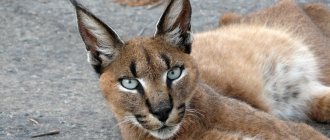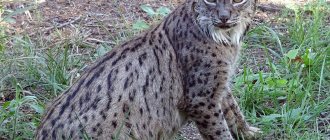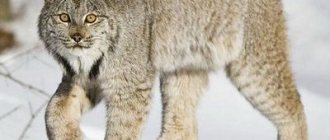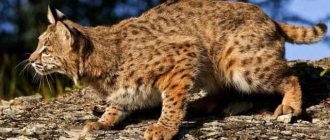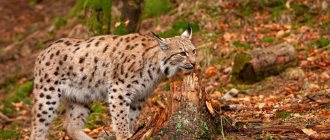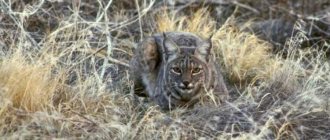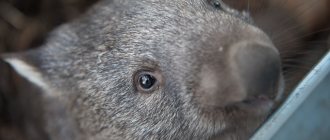Appearance Features
The lynx is a medium-sized animal with a relatively short body, raised high on its legs and a wide, short head. Unlike other wild cats, the animal’s tail is short, like a “cut” - from 9 to 12 centimeters in length, its tip is black.
Lynxes are very mysterious animals and have earned themselves the nickname “shadow of the forest.”
The legs are quite thick, and at the same time slender, with large rounded paws with sharp retractable claws. Most animals live in areas where everything is buried in deep snowdrifts in winter, and their elongated limbs help them maneuver in this snowy environment. In addition, in winter the paws are well furred: the hair on the underside of the limbs provides traction on slippery surfaces. The exception is the red lynx, which does not have furry soles like its relatives, but it does not live in areas of heavy snowfall. In general, no other feline animal is as well adapted to snow and cold as our heroine.
The winter fur of the lynx is up to 10 cm long, soft and thick, and has different colors: golden, ash-blue, smoky, gray-brown, red. Moreover, there is such a pattern: the colder the climate in which the animal lives, the lighter the fur. Almost always it is dotted with dark spots, large on the back and sides, small on the legs. On the belly and chest, the fur is even longer and softer, almost always pure white with rare speckles. Around the neck the coat is more luxuriant and forms a collar.
Summer fur is more brightly colored, coarser and shorter than winter fur.
The lynx's calling card is its ears - small, erect, triangular in shape, crowned with long black tassels. All types have brushes, but their purpose is not entirely clear. Some scientists believe that they enhance the animal’s hearing, others that they are needed for communication between animals.
The animal's face is decorated with whiskers - elongated sections of fur on both sides of the chin. The lynx's eyes are round, elliptical in shape, the outer corners of the eyes form an acute angle, the color of the iris is usually sandy.
Lynx structure
The study of the anatomical structure of animals, taking into account their characteristic features belonging to a certain breed and species, sexual characteristics and age characteristics is extremely necessary in the development of biological sciences.
Zoologists, ethologists, trackers, hunters and many people interested in the life of the lynx wild cat study its habits, behavioral characteristics and traces of vital activity. The anatomy of the lynx allows them to understand and master knowledge not only of the external structure of the animal, but also to comprehend the internal structure of the body.
Among other things, the anatomy of a lynx is capable of revealing the potential capabilities of a predator, as well as anticipating and managing the paths of evolutionary improvement of its body.
Lifestyle and habitat
Since these animals are now few in number, they lead a predominantly secretive lifestyle. Accordingly, the chance of seeing it in the wild is quite small. Even with a strong desire, it is not so easy to find a cat, since it prefers such supports that are not easy to get close to. For example, it could be an old cluttered windfall or a dark taiga forest with a dense undergrowth of coniferous trees.
However, there is a chance to meet a lynx in a young forest. The predator does not attack humans, preferring to avoid encounters. The animal is able to recognize the presence of a person at a distance of several hundred meters, after which it begins to silently leave, occasionally stopping to listen.
If the lynx is very hungry, it may even go into the city, where it will attack a dog or cat. Even an adult shepherd cannot compare in strength to a predator. However, few cases of lynx appearing in cities have been observed, as they prefer dark coniferous forests.
Lynx is a wild animal , therefore it prefers a nocturnal and twilight lifestyle. It starts hunting after dark. It feeds mainly on hares. If possible, it may attack an ungulate animal: roe deer, wapiti or young wild boar. Easily catches a squirrel or marten. The meat of hazel grouse, black grouse and wood grouse is considered a favorite delicacy. In the winter season, it tracks holes.
An interesting fact is that the lynx does not like foxes, so it hunts them as soon as the chance arises. However, he doesn’t eat it. The hunting qualities of these cats are even better than those of leopards and wolves. With the onset of evening, everything around becomes silent and at this time the lynx goes out to hunt, listening to the smallest sounds.
Having determined that there is prey nearby, the cat slowly makes its way to it, without making unnecessary noise. A convenient distance for an attack is considered to be 10–20 m. 2–3 jumps are enough to grab onto the food. If the prey, for example, a hare, senses something is wrong and starts to run away, the lynx may chase it for a short time, 50 - 100 m, after which it stops.
Sneaking is not the only hunting style. He also prefers a wait-and-see position, in ambush. Favorite places are hare trails or ungulate watering holes. The lynx does not like to jump from trees, although it can rest on branches with all 4 paws hanging down.
Prey in the form of 1 hare will be enough for a cat for 2 days. If the trophy is a roe deer, this provides the animal with food for the week ahead. It happens that the prey is too large, in which case the lynx buries it in the ground or snow, depending on the time of year.
The lifestyle is sedentary. Looking for prey, it can move over distances of up to 30 km. Lynx is a predator that prefers solitude. The only exception is females with cubs - they spend several months together. This is enough to teach newborns hunting skills.
First, the female brings live animals to the babies, for example, mice or hares. After they grow up, the lynx begins to take their offspring with them on hunts. With the onset of February, the adult will drive the kittens away, since it is time for them to survive on their own in the taiga.
Lifestyle, behavior, nutrition
Since lynxes are territorial hunters, they lead a solitary lifestyle. They have a very large range, the largest of any cat. The territories of males are larger and often overlap with the territories of several females.
Lynx nutrition. How does the animal hunt?
The beast hunts both small and large mammals. Birds and fish are also included in its diet.
Although the lynx is a land mammal, it often climbs trees or swims to catch prey.
The main source of food for the Canada lynx is the mountain hare, even its population increases or decreases depending on the amount of this prey. In addition, its diet includes small rodents such as squirrels, mice, gophers, etc. This species often feasts on birds (such as willow partridges and grouse) if they manage to catch them.
The Eurasian lynx, as the largest species, often hunts ungulates such as deer, roe deer and chamois, supplementing its diet with hares, rodents, birds and their eggs.
A lynx can jump 2 meters in height.
Smaller species - Iberian and red lynxes, usually catch animals no larger than a rabbit.
During the day, the lynx rests in dense thickets of bushes, rock crevices or caves, and with the onset of dusk its active life begins. She has excellent eyesight and exceptional hearing, so she easily finds prey.
Lynxes are not as fast or strong runners as some of their feline relatives. They cannot chase prey, especially if the snow is deep. Therefore, their favorite way of hunting is to ambush their prey. A lynx can hide behind trees, rocks, bushes or tall grass and wait until a potential prey passes by. In addition, these agile steeplejacks often wait for prey, sitting on tree branches.
The lynx cannot kill a large animal with a blow of its paw, so it deals with it with the help of sharp claws and teeth, thrusting them deep into the body of the victim.
Population and species status
On the territory of the Balkan Peninsula there are no more than a few dozen individuals, and in Germany, Switzerland and France at one time lynxes were completely exterminated, which required their repopulation.
The largest numbers of this predator are observed in the Carpathians and Poland. No less numerous populations are also characteristic of Belarus, Scandinavia, Central Asia, Latvia and Estonia. This representative of the cat family is also found in Siberia.
The common lynx is not of particular importance for commercial production, although the fur of this animal is highly valued. This is due to the fact that the lynx has thick, silky and long (up to 7 cm) fur, with a rather thick and warm undercoat. It should be noted that lynxes play a very important role in maintaining the balance of nature.
It is believed that the taste characteristics of lynx meat are quite high, since its taste characteristics are similar to veal. Despite this, in most countries lynx meat is not eaten, although it is quite tasty and tender.
Interesting to know! In ancient times in Rus', rich nobles were treated to lynx meat, and dishes prepared from the meat of this animal were always present on the tables of boyars and princes as an expensive delicacy.
A characteristic feature of European territory is the fact that even in the last century the number of lynxes did not exceed several hundred individuals.
In the territory of European countries, even in the last century, the number of common lynx decreased significantly and amounted to only a few hundred individuals. This became possible due to the fact that forests began to be actively destroyed, poaching began to flourish, and against this background the food supply was reduced. Nowadays, a lot of measures are being taken that are aimed at preserving the populations of this unique animal, as well as, if possible, increasing its numbers.
Predator Paws
The lynx is endowed with long limbs with wide, powerful paws. The prints of the front feet are round in shape, the hind ones are elongated and more oval. The diameter of the front paw prints of an adult animal in summer is approximately 7.7x7.9 cm. In winter, the animal’s feet become heavily overgrown with long hair, which covers the entire surface of the sole and increases its print on the snow at least twice - up to 16-17 cm in diameter , and sometimes up to 23 cm. The size of the footprint of the hind legs in the warm season is 7x9 cm.
The predator has four toes on its hind limbs and five on its front limbs. The fifth, thumb, is very shortened, not opposed to the others and is placed higher, so it does not leave an imprint when walking. Lynxes are digitally walking animals; their voluminous toe pads and metatarsal pads evenly distribute the mass of the predator over the entire foot.
Natural habitat
In the wild, lynxes are found only on two continents - Eurasia and North America. These animals are the northernmost species of cats, and are found even beyond the Arctic Circle.
The lynx family was once found throughout Europe but was extirpated from the western and central parts of the continent, and efforts are now being made to reintroduce the spotted beasts to countries such as Germany, France and Switzerland.
In the wild, lynxes inhabit the following regions:
- Russia, including the Far Eastern Kamchatka Peninsula and Sakhalin Island;
- Ukraine, including the Chernobyl zone;
- Poland;
- Belarus;
- Carpathian mountain range from the Czech Republic to Romania;
- Scandinavian Peninsula;
- Baltic countries;
- Balkan Peninsula;
- Transcaucasia: Armenia, Georgia, Azerbaijan;
- Central Asia: Tajikistan, Kyrgyzstan, Turkmenistan, Uzbekistan, Kazakhstan;
- China;
- Mongolia;
- Alaska;
- Canada;
- USA;
- Mexico.
Spotted cats prefer to settle in dense taiga and coniferous forests; they also like high mountain areas. Lynxes also wander into the forest-tundra, because thanks to their thick fur, they feel great among the polar snows. They can also live in steppe regions, choosing rough places with bushes.
Where do they live?
The lynx's habitat covers North America, northern and central Europe and Asia. A few local populations are found in Germany, Italy, Spain, and the countries of the Balkan Peninsula. The lynx is found in the Caucasus, Turkey, Pakistan, Iraq and Iran.
Where live
The most suitable habitat for lynxes is dense coniferous forests. The highest population density is observed in the taiga. In such natural zones as tundra, forest-tundra, forest-steppe, where open areas predominate, the animal is much less common.
Observation of predators living in the Stolby, Bashkiria nature reserves, and the Voronezh Natural Biosphere Reserve made it possible to establish that each adult occupies a forest area of up to 200 square meters. km. If there is enough prey, the plots may be smaller. The lynx leaves its habitat only in exceptional cases: in the absence of food or during a natural disaster.
Reproduction and raising of offspring
Reproductive age in lynxes occurs when they reach 2 years of age. Females are ready to bear offspring at 22-24 months of life, males mature later, and are capable of reproduction when they are 2.5 years old.
The mating season for lynxes occurs only once a year; their rut begins in February and ends with the arrival of April.
Mating season
The entire forest district knows that lynxes have begun mating. Usually these cats are quiet and silent, which is natural, because they do not need to give themselves away with unnecessary sounds while hunting or when encountering other predators. But during the breeding season, spotted animals forget about caution and announce the surroundings with growls, meows and prolonged howls.
A couple of lynxes in love
One spotted lady is courted by several males at once. They behave exactly like March cats: they scream, howl and delight the ears of females with romantic “serenades”. And of course, it doesn’t happen without fights. Excited gentlemen find out which of them is most worthy to mate with the female in a fair duel.
First, males try to intimidate their opponents by hissing and hoarse meows. If the competitor is not impressed, then a fight cannot be avoided, during which the lynxes, without a twinge of conscience, use all the weapons available to them, that is, teeth and claws. Their battles do not lead to deaths, but after them the males remain with battle marks and scars.
The winner proudly leaves with his chosen one, and the loving couple spends about a week together. The relationship between them is very warm and reverent, the lynxes gently butt their foreheads, rub their noses, as if kissing, and affectionately lick each other’s fur as a sign of affection. During the time spent together, the couple mates several times, and at this point their marriage is considered dissolved, so they go in different directions, and most likely will never meet again.
During the mating season, females enter into sexual relations with only one partner, and the males adhere to polygamous views, and after parting with their chosen one, they go in search of another lady of their heart.
Duration of pregnancy and childbirth
Female lynx bear their offspring for 62-70 days, and their total gestation period is just over 2 months. A couple of weeks before giving birth, the expectant mother begins to search for a suitable shelter, choosing the most remote and difficult places. They usually build a brood nest in earthen caves or among windbreaks, where the lair will be hidden from prying eyes by upturned tree trunks.
Newborn lynx babies
Females understand that the shelter for raising offspring must be warm and cozy, so they carefully line its bottom with bird feathers, dry grass and the soft hair of fur-bearing animals.
In one lynx litter, only 1-3 babies are born; in very rare cases, a litter consists of 4-5 lynx cubs. Like all kittens, lynx cubs are born blind and deaf, and their weight does not exceed 250-300 g. Babies develop quickly, already at 1 week their fur becomes longer and fluffier, and their eyes open on the 12th day of life. By the way, newborn lynx cubs do not look at all like their parents; their irises are bright blue, and their fur has a reddish-brown tint. Only by the age of one and a half years will they acquire the appearance of adults, acquiring a characteristic color and tassels on their ears.
Caring for the Cubs
Lynxes are extremely responsible and caring mothers. The first month after birth, they leave the cubs only for a couple of hours, and hunt near the den, so that in case of danger they quickly return back. Females gently lick their babies, and also vigilantly monitor the cleanliness of the shelter, clearing it of debris and removing waste from the kittens.
If a lynx discovers other animals near the shelter, it immediately moves its descendants to a safer place. And of course, if attacked by a predator, the female will fight to the last for the life of her cubs.
Spotted kittens feed on their mother's milk for 1 month, after which the mother begins to accustom them to solid food. First, the female feeds the babies with fresh pieces of meat, and when they reach 2 months of age, she brings them half-dead small prey in the form of hamsters and mice. So lynx cubs early learn the wisdom of hunting and getting their own food, because soon they will have to learn to survive alone.
Young lynx cubs receive survival lessons from their mother
About 3 months after giving birth, the lynx finally brings its heirs into the wide and beautiful world. During this time, the kids have already become quite strong and can follow their mother, simultaneously gaining hunting knowledge. Young lynx cubs learn to climb trees, swim and track prey, in general, useful skills that will be useful to them in adulthood.
The cubs remain near the mother until the next mating season, with the onset of which she drives away the previous offspring. But, if for some reason the lynx failed to become pregnant again, then the entire next year their family will stay together. True, such cases are rare in the wild, and usually lynx cubs at one year of age already begin a solitary and dangerous independent life.
Question to an expert Can lynxes purr? Yes, lynxes purr like domestic cats. Well-fed predators love to stretch, sharpen their claws on trees and purr with satisfaction at the same time. And mother lynxes often sing a purring lullaby to their babies, which has a calming effect on them and makes them feel safe.
How do they reproduce?
The breeding season for lynxes occurs in February. Animals living separately change their habits: males and females begin to meow loudly, attracting individuals of the opposite sex. Animals that have formed a pair during the mating season show each other signs of attention: pushing their foreheads, rubbing their noses, licking their fur.
After mating, the pair separates. The female begins preparations for the appearance of offspring. She sets up a secluded den, lining it with dry grass, wool and bird feathers. Pregnancy in lynxes lasts a little more than 2 months, after which 1 to 4 blind and deaf kittens are born. Newborn lynx cubs weigh about 300 grams and differ from adult animals in color and the absence of tufts on their ears. For the first 8-10 weeks, the cubs feed only on mother's milk. At 3-4 months, the babies begin to eat meat brought by the female. At the same age, they leave the hole for the first time and go on their first hunt under the supervision of their mother.
The cubs live with the female until the next mating season. If the female fails to become pregnant, the offspring remain with her for another year. If pregnancy occurs, the lynx leaves the kittens, which continue to live and hunt together for some time.
Enemies and threats
The lynx's natural enemies are mainly cougars, coyotes and wolves.
Wolves actively and purposefully pursue lynxes, so where there are many wolves, these cats are not present. They are also major food competitors. In normal competition between these species, the lynx loses in terms of reproduction and its ability to adapt to environmental changes.
Because Canada lynxes are medium-sized predators, they face threats from other forest animals. Large carnivores such as cougars and wolves are its direct predators. Coyotes, although relatively small, may also prey on this cat.
In addition, coyotes and wolverines may try to steal the bobcat's prey. Wolverines are very aggressive and will chase away a competitor from caught prey.
In addition to predators, the lynx is also threatened by people who destroy its habitat. Cats are finding it increasingly difficult to find food, and in some areas their forest habitats are being cut down for agricultural purposes.
A big problem for these beautiful animals is hunting. Soft, luxurious fur that keeps the animal warm and comfortable during the colder months is very popular in the fur industry, especially in light shades. It is estimated that about 90 thousand Eurasian lynx pelts are sold in fur markets annually.
In addition, a lynx, if it has settled near human habitation, can attack livestock. For this reason, it has always been exterminated by farmers. Hunters also do not like this cat, because they believe that its presence in a given territory reduces the number of game.
Share with your friends:

